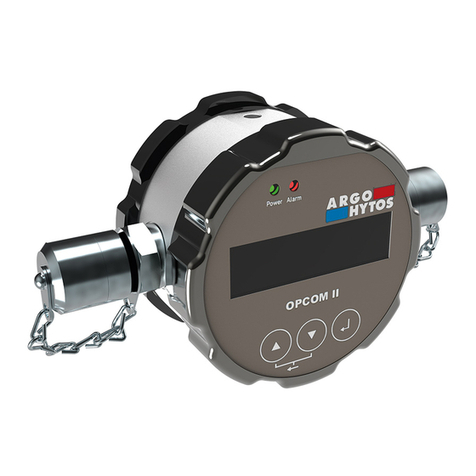
Subject to change · V 4.06.19 · EN
Page 2 www.argo-hytos.com
Contents
OPCom Portable Oil Lab
Contents........................................................................................................................................................................ 2
1. About this documentation.......................................................................................................................................... 4
1.1 Applicability of this documentation................................................................................................................................. 4
1.2 Required and supplementary documentation .................................................................................................................. 4
1.3 Presentation of information ............................................................................................................................................ 4
1.3.1 Safety instructions in this documentation ....................................................................................................................... 4
1.3.2 Symbols.......................................................................................................................................................................... 5
2. Safety instructions....................................................................................................................................................... 6
2.1 About this chapter.......................................................................................................................................................... 6
2.2 Intended use................................................................................................................................................................... 6
2.3 Improper use ................................................................................................................................................................. 6
2.4 Reasonably foreseeable misuse ....................................................................................................................................... 6
2.5 Qualification of personnel .............................................................................................................................................. 6
2.6 General safety instructions.............................................................................................................................................. 7
2.7 Product and technology related safety instructions ......................................................................................................... 7
3. General instructions .................................................................................................................................................... 8
4. Scope of delivery ......................................................................................................................................................... 9
5. About this product..................................................................................................................................................... 10
5.1 Functional description................................................................................................................................................... 10
5.2 Measured values ........................................................................................................................................................... 10
5.3 Component overview ................................................................................................................................................... 11
5.4 Controls........................................................................................................................................................................ 12
5.5 Control panel................................................................................................................................................................ 12
5.6 Printer........................................................................................................................................................................... 13
5.4 Identification of the product ......................................................................................................................................... 13
6. Transport and storage ............................................................................................................................................... 14
7. Assembly .................................................................................................................................................................... 15
7.1 Operating site............................................................................................................................................................... 15
7.2 Hydraulic connection .................................................................................................................................................... 15
7.3 Electrical connection ..................................................................................................................................................... 17
7.4 Charging process .......................................................................................................................................................... 18
8. Commissioning........................................................................................................................................................... 19
8.1 Before commissioning .................................................................................................................................................. 19
9. Operation.................................................................................................................................................................... 20
9.1 Operation ..................................................................................................................................................................... 20
9.2 Menu structure ............................................................................................................................................................. 21
9.2.1 Switching on the device ................................................................................................................................................ 23
9.2.2 Start screen................................................................................................................................................................... 24
9.2.3 Measurement quick menu............................................................................................................................................. 25
9.2.4 Memory quick menu..................................................................................................................................................... 25
9.2.5 Main menu ................................................................................................................................................................... 26
9.2.5.1 Memory menu .............................................................................................................................................................. 26
9.2.5.2 Measurement settings................................................................................................................................................... 28
9.2.5.3 System settings ............................................................................................................................................................. 31
9.2.5.4 Select start screen ......................................................................................................................................................... 31




























